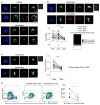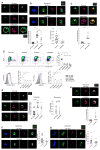Asymmetric PI3K Activity in Lymphocytes Organized by a PI3K-Mediated Polarity Pathway
- PMID: 29420173
- PMCID: PMC5806629
- DOI: 10.1016/j.celrep.2017.12.087
Asymmetric PI3K Activity in Lymphocytes Organized by a PI3K-Mediated Polarity Pathway
Abstract
Unequal transmission of nutritive signaling during cell division establishes fate disparity between sibling lymphocytes, but how asymmetric signaling becomes organized is not understood. We show that receptor-associated class I phosphatidylinositol 3-kinase (PI3K) signaling activity, indexed by phosphatidylinositol (3,4,5)-trisphosphate (PIP3) staining, is spatially restricted to the microtubule-organizing center and subsequently to one pole of the mitotic spindle in activated T and B lymphocytes. Asymmetric PI3K activity co-localizes with polarization of antigen receptor components implicated in class I PI3K signaling and with facultative glucose transporters whose trafficking is PI3K dependent and whose abundance marks cells destined for differentiation. Perturbation of class I PI3K activity disrupts asymmetry of upstream antigen receptors and downstream glucose transporter traffic. The roles of PI3K signaling in nutrient utilization, proliferation, and gene expression may have converged with the conserved role of PI3K signaling in cellular symmetry breaking to form a logic for regenerative lymphocyte divisions.
Keywords: FoxO1; Pax5; TCF1; Warburg effect; actin; anabolism; asymmetric division; mTOR; stem cell.
Copyright © 2017 The Author(s). Published by Elsevier Inc. All rights reserved.
Conflict of interest statement
The authors declare no competing interests.
Figures




References
-
- Caro-Maldonado A, Wang R, Nichols AG, Kuraoka M, Milasta S, Sun LD, Gavin AL, Abel ED, Kelsoe G, Green DR, et al. Metabolic reprogramming is required for antibody production that is suppressed in anergic but exaggerated in chronically BAFF-exposed B cells. J Immunol. 2014;192:3626–3636. - PMC - PubMed
-
- Chang JT, Palanivel VR, Kinjyo I, Schambach F, Intlekofer AM, Banerjee A, Longworth SA, Vinup KE, Mrass P, Oliaro J, et al. Asymmetric T lymphocyte division in the initiation of adaptive immune responses. Science. 2007;315:1687–1691. - PubMed
Publication types
MeSH terms
Substances
Grants and funding
LinkOut - more resources
Full Text Sources
Other Literature Sources
Research Materials
Miscellaneous

